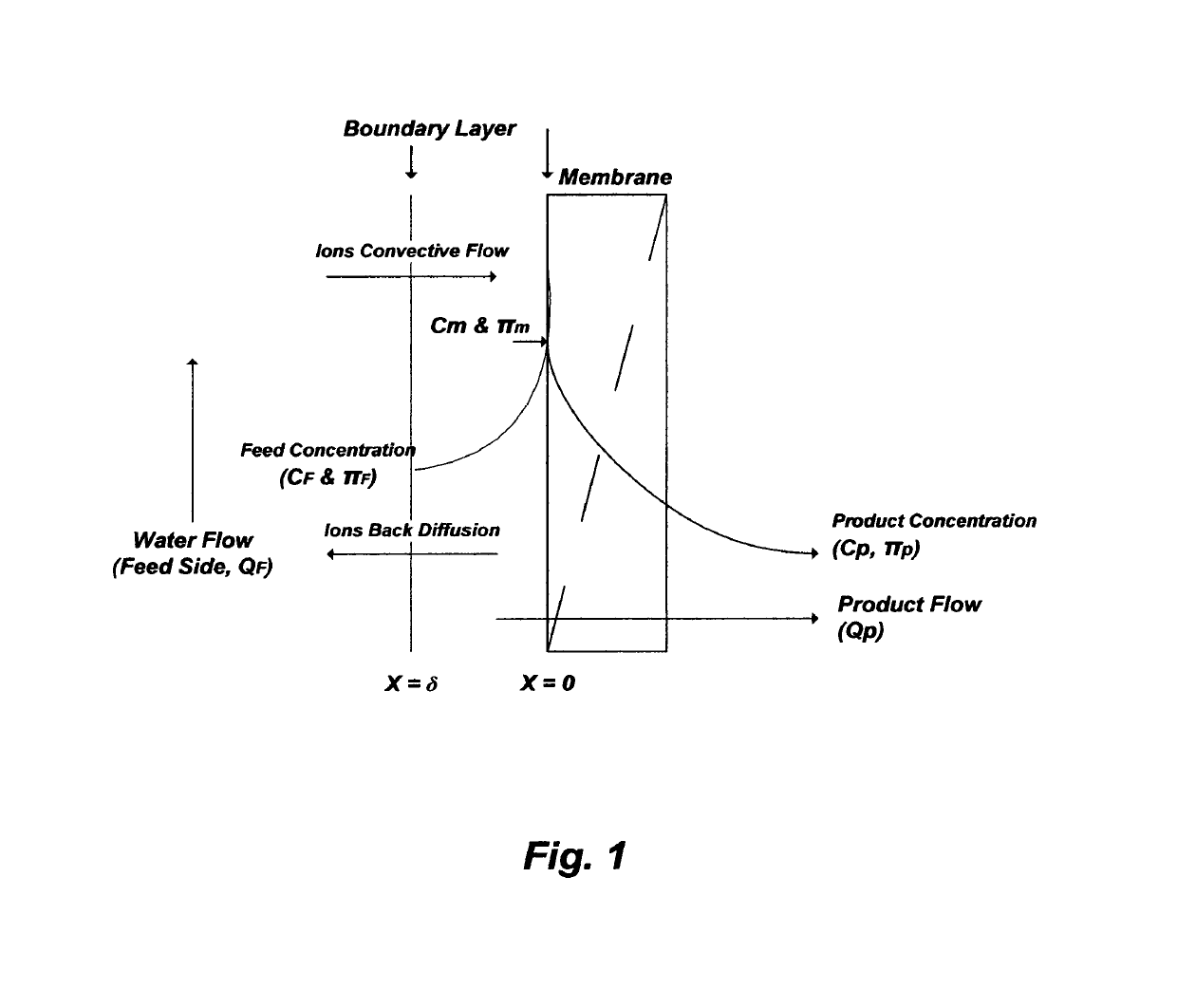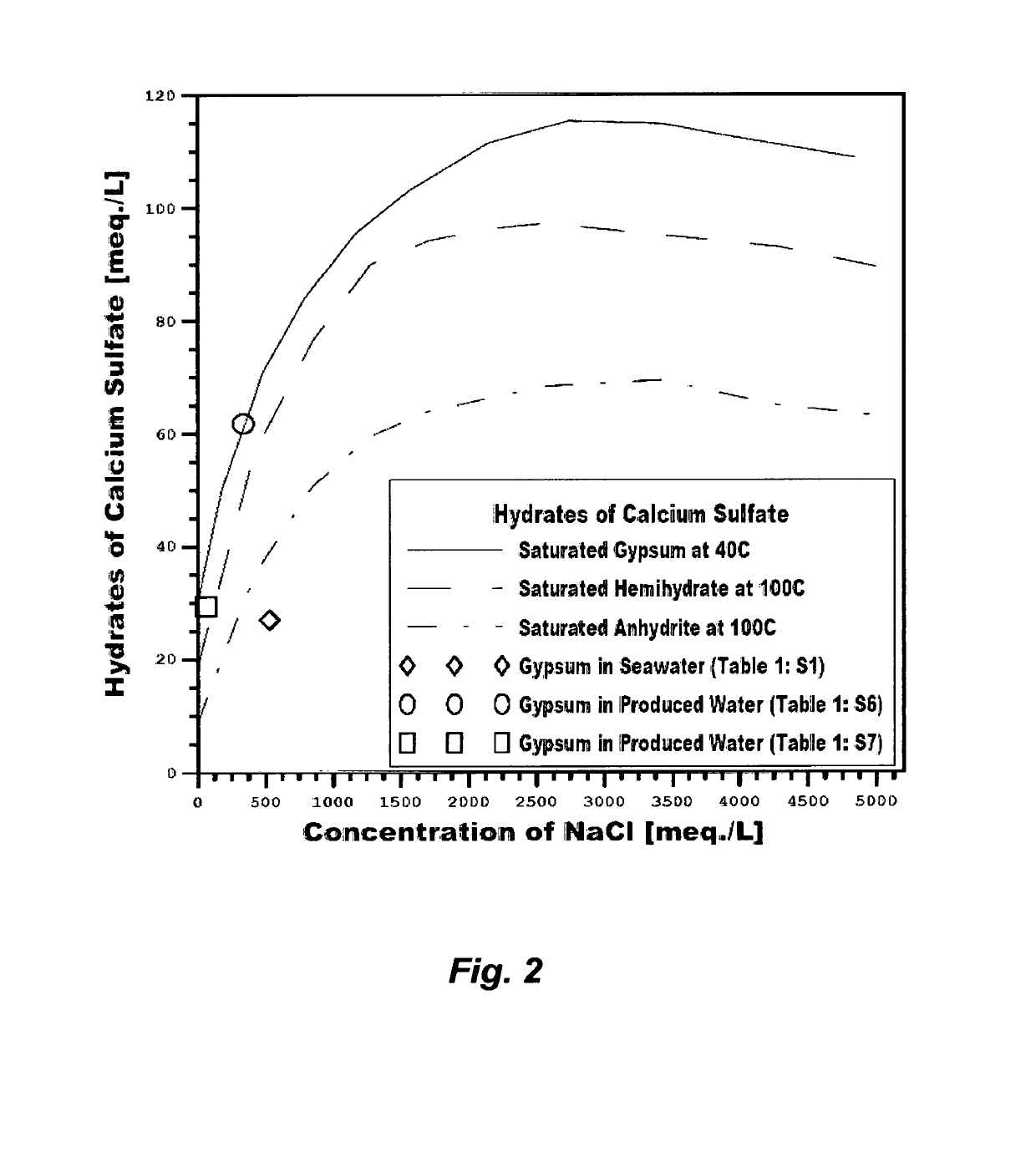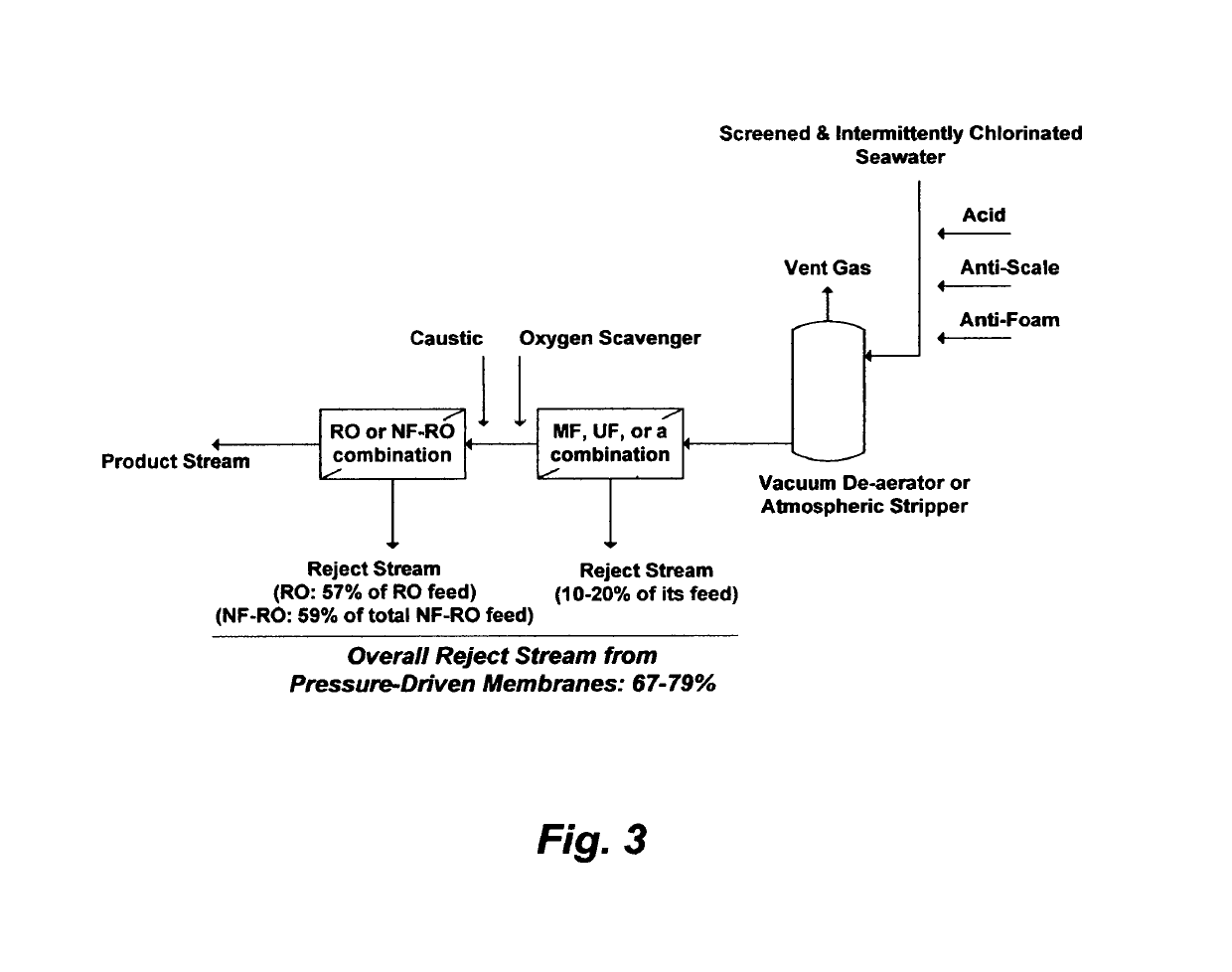However, the ions content may increase in situations where very large amounts of reject streams from de-salting methods are blown back to a sea, especially in a bay or a semi-closed sea.
The
discharge of enormous volumes of reject streams from de-salting methods elevates
total dissolved solids (TDS), including scale prone species, around the
seawater intake lines, particularly when the dispersion of reject streams is not fast enough.
This, in turn, has a detrimental effect on de-salting methods.
Yet, reject streams are depleted of dissolved
oxygen, and enriched with residues of
oxygen scavengers, potential toxic species (e.g., derivatives of
boron,
chlorine and
bromine) and
gypsum; which adversely affect marine environment.
The saturation envelops of such hydrates directly control the
recovery ratio of any de-salting method, cause enormous
engineering difficulties, and hinder
water production at a low cost.
Rather than eliminating
calcium sulfate hydrates to obviate their profound limitations on any de-salting method, the nature of
calcium sulfate hydrates is instead manipulated, to operate inefficient and costly de-salting methods.
On the other hand, one of the disadvantages of such a configuration is that the total product stream may not meet the permissible: (1) TDS range in drinking water (200-500 mg / L) since the product stream of RO membranes is generally entrained with dissolved ions (high but still incomplete ions rejection) whereas the second stage, in particular, is further strained by the higher TDS in the reject stream from the first stage (the feed stream for the second stage); and / or (2) stringent
boron content in drinking water (0.5 mg / L) since RO membranes are incapable of efficiently removing
boron species at an acidic
pH level (
boric acid form) or even a near
neutral pH range (nearly equally
boric acid and borate forms) unless a caustic solution is added to the RO feed stream at a
pH level of about 10.5-11 (borate form), which is prohibitive (precipitate
magnesium hydroxide).
However, the 12%
gain in the RO's overall
recovery ratio would come at a significant capital expenditure (the cost of adding the NF step is nearly as much as the cost of the RO step), an enormous pumping power since both NF and RO are high-pressure membranes, and the combined reject stream (59%) from both the NF and RO setups actually exceeds the total reject stream (57%) from the standalone RO setup (FIG. 4, Configuration A).
The sudden introduction of heated
seawater into a lower pressure stage causes it to boil so rapidly as to flash into vapor.
At such a low
recovery ratio, the TDS
gain in reject brine is also low.
In addition, an RB-MSF
train is more susceptible to
hemihydrate and
anhydrite scale than an OT-MSF
train since it is operated at a top brine temperature of about 110° C. Furthermore, an RB-MSF
train incurs additional enormous operating costs due to at least the required high pumping power to circulate and reject an enormous volume of cooling seawater and to constantly re-circulate an enormous volume of recycle brine.
Yet, reject brine from an RB-MSF train is heavily infested with scale prone species than reject brine from an OT-MSF train, thereby is more harmful not only to marine environment but also to an RB-MSF
desalination plant itself (e.g., alters the natural ions composition of seawater around intake lines).
Thus, there is no difference between an OT-MSF desalination
plant and an RB-MSF desalination
plant in terms of actual distillate recovery ratio, but an OT-MSF desalination plant is less damaging to marine environment and more economic than an RB-MSF desalination plant, and yet both types of plants remain crippled by
sulfate scale.
As
water cut rises in wet oil, so do the expenses and the problems associated with it.
Artificial lift equipment, gathering flow lines, wet oil gathering centers, and
produced water treatment and disposal systems may reach their operating capacity limits quickly.
This forces frequent expensive modifications and / or expansions to flow lines and centers, or a reduction in wet
oil production.
Water is thus one of the most pressing issues in any wet
oil production facility.
However,
crude oil consists of a very large number of organics, most of which are hydrocarbons and derivatives of hydrocarbons (heteroatoms), and many of which are structurally undetermined or difficult to identify.
Heteroatoms are common in
heavy crude oil and bitumen, which render them appreciably acidic.
Thus,
biodegradation negatively impacts the economy of
oil production in terms of quality (e.g., degraded oil due to a decrease in the amount of paraffins), processibility (e.g., generation of surface active species, promotion of
corrosion, impairment and resistant of catalytic hydro-treatment in refining
crude oil, and emission of
NOx and SOx), and treatability of by-product waters (e.g.,
produced water,
refinery's
wastewater, and the like).
On the other hand, their hydrophilic groups are surface active when the
carbon number is greater than 7 (species with
carbon number <7 may be more soluble in water, and thus may not be surface active), which causes severe scaling problems.
In addition, the availability of
radium in
produced water suggests that the decay series of
radium's isotopes is common, and thus such water may be radioactive.
However, sulfate-rich produced waters tend to contain an appreciable concentration of
calcium, minor concentration of
strontium, but may be depleted of
barium and
radium.
However, none of the above mentioned de-oiling steps, individually or collectively, may be capable of efficiently removing TOC, and thus a significant portion of TOC may remain in the treated produced water as
emulsion-scale and / or
toxicity contributors.
In addition, such de-oiling steps are not ZLD since they produce oily
waste stream (e.g., skim tanks, hydrocyclones, centrifuges, MF, and UF), oily stripping streams (e.g., extraction by polymers), and exhausted oily adsorption materials (e.g.,
activated carbon, nutshell, and
manganese dioxide) that require a proper disposal path and / or a further treatment.
Produced water treatment thus remains a dual problem since neither the
oil phase is sufficiently recovered (de-watered) in a useful form nor is the water phase sufficiently de-oiled, and yet there are still the questions of the: (1) disposal of oily waste streams, oily stripping streams, exhausted adsorption materials, or a combination; (2) environmental
impact of discharging produced water; and (3)
beneficial use of produced water.
As a result, offshore produced
water discharge limits may be frequently violated; onshore
surface discharge of produced water remains restricted; and the beneficial usage of produced water by de-salting methods remains hindered since neither efficient nor economic de-salting methods can be operated in the absence of efficient de-oiling (as well as de-scaling).
This would seem to be unusual since the technical inferiorities of such systems are recognizable.
Thus, directly de-salting such produced waters would be heavily impaired if not virtually impossible since any of the calcium sulfate hydrates may be dominant.
From strictly de-oiling and de-scaling standpoints, such a primitive application “drift” does not offer the capability demanded nor does match the nature and
chemistry of produced waters.
The combined de-oiling units and membrane
filtration units, despite of their excessiveness, do not remove dissolved oil, which would be carried over to the de-salting units as foulants.
Of equal importance, the de-salting units may nearly immediately impair due to excessive scale build-up as a result of the already
gypsum saturated produced waters and the presence of calcium
chloride that depresses the
solubility limit of
gypsum, which would be further compounded by the effect of
concentration polarization (FIG. 1) at membranes' surfaces.
From strictly de-oiling and de-scaling points of view; let alone other
engineering, metallurgical, economical (capital and operating costs) and environmental issues that may be prohibitive; the design is inadequate for two profound reasons.
First, the de-oiling steps are deficient since they generate a roughly de-oiled stream that carries over dissolved oil to the feed
heat exchanger, steam stripper and MVR system.
The carried over dissolved oil acts as a foulant for
heat transfer surfaces and causes severe foaming problems (e.g., a compressor failure and / or a liquid
discharge from vapor heads).
Second, produced water is already saturated with calcium sulfate before
processing.
Aside from the feed
heat exchanger and steam stripper that are directly subjected to calcium sulfate scaling, the seeding concept within the
evaporator to minimize tubes plugging is also ineffective.
Thus, the metastable
hemihydrate would continuously deposit on the heat transfer tubes even though calcium sulfate is readily supersaturated in the
slurry but the
anhydrite stable form may not be attained quickly enough to minimize tubes plugging.
Thus, the seeding mechanism is very difficult to control since the: (1) seeding agent may be a mismatch (in terms of type, form, particle size, and combinations of these factors) even though it is in the form of sulfate; and (2) amount of the seeding agent is considerable.
As a consequence, the seeding mechanism: (1) requires a high flow rate to evaporate produced water in the heat transfer tubes, which may diminish the
evaporation efficiency; and (2) is not adoptable in multi-stage flash evaporators wherein the
boiling point of brine is successively reduced by reducing pressure (FIG. 5).
 Login to View More
Login to View More 


